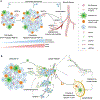Current concepts in granulomatous immune responses
- PMID: 34095894
- PMCID: PMC8174606
- DOI: 10.1007/s42977-021-00077-1
Current concepts in granulomatous immune responses
Abstract
Persistent irritants that are resistant to innate and cognate immunity induce granulomas. These macrophage-dominated lesions that partially isolate the healthy tissue from the irritant and the irritant induced inflammation. Particles, toxins, autoantigens and infectious agents can induce granulomas. The corresponding lesions can be protective for the host but they can also cause damage and such damage has been associated with the pathology of more than a hundred human diseases. Recently, multiple molecular mechanisms underlying how normal macrophages transform into granuloma-inducing macrophages have been discovered and new information has been gathered, indicating how these lesions are initiated, spread and regulated. In this review, differences between the innate and cognate granuloma pathways are discussed by summarizing how the dendritic cell - T cell axis changes granulomatous immunity. Granuloma lesions are highly dynamic and depend on continuous cell replacement. This feature provides new therapeutic approaches to treat granulomatous diseases.
Keywords: VEGF; cell traffic; dendritic cells; granuloma.
Conflict of interest statement
Conflicts of interest: The authors have no relevant financial or non-financial interests to disclose.
Figures


References
Publication types
MeSH terms
Grants and funding
LinkOut - more resources
Full Text Sources
